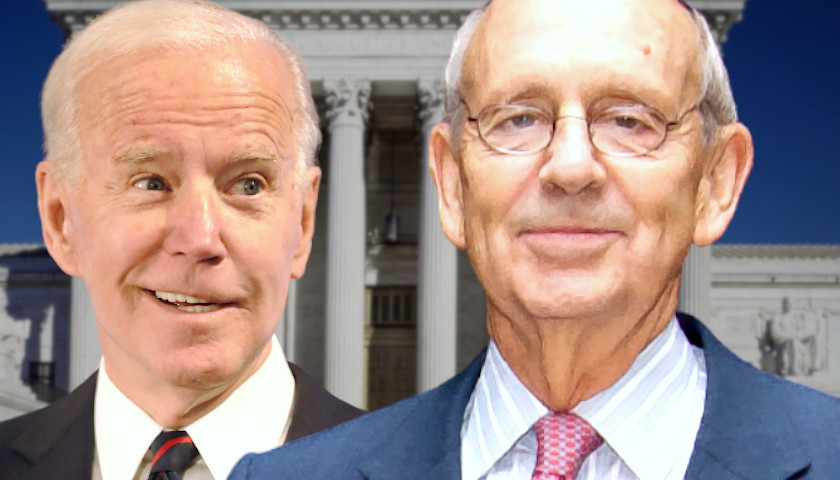The second most senior Supreme Court associate justice decided to retire from the high court bench at the end of the court’s session in June, according to multiple media reports.
There was no official statement from the Supreme Court, but White House Press Secretary Jennifer R. “Jen” Psaki Wednesday confirmed the retirement of Associate Justice Stephen G. Breyer on Twitter.
“It has always been the decision of any Supreme Court justice if and when they decide to retire, and how they want to announce it, and that remains the case today. We have no additional details or information to share from White House,” she said.
It has always been the decision of any Supreme Court Justice if and when they decide to retire, and how they want to announce it, and that remains the case today. We have no additional details or information to share from @WhiteHouse
— Karine Jean-Pierre (@PressSec) January 26, 2022
The Supreme Court vacancy presents President Joseph R. Biden Jr. with the opportunity to make a lasting impression on the highest court in the land.
Breyer’s retirement comes after Democrats have pressured the judge to step down, including Rep. Alexandra Ocasio-Cortez (D-NY-14), as Democrats face losing control of the Senate in the 2022 midterm election.
Right now, Senate Democrats control their chamber by holding 48 seats, plus two Independents, caucusing with the Democrats, and with Vice President Kamala Harris ready to break any tie.
Senate Republicans hold 50 seats, which means with one Democratic defector, the Republicans have a simple majority.
Going into the 2022 midterm election, there are three Senate Democrats in trouble, Georgia’s Raphael G. Warnock, Nevada’s Catherine Cortez-Masto and Arizona’s Mark E. Kelly.
In their 2020 campaigns to fill unfinished terms, Kelly and Warnock won their races with 51 percent of the vote. Cortez-Masto won her first term in 2016 with 47 percent of the vote.
Clinton nominated Breyer before Democrats lost the Senate in 1994
Without a working majority in the Senate, Democrats would be in the same situation they found themselves in when the death of Associate Justice Antonin G. Scalia gave President Barack H. Obama, Jr. the opportunity to nominate Chief Judge of the U.S. Court of Appeals for the District of Columbia Circuit Merrick B. Garland to fill the vacancy.
In 1994, Democratic President William J. “Bill” Clinton was confronted with the retirement of Associate Justice Harry A. Blackmun, as the “Contract with America” wave led by House Minority Leader Newton L. “Newt” Gingrich (R-GA-06) was poised to challenge Democratic control of the Senate, which then stood at 56 Democrats and 44 Republicans.
The story goes that Utah’s Sen. Orrin G. Hatch, then the top-ranking Republican on the Judiciary Committee, got a call from Clinton and that Hatch told the president if he nominated Breyer, Hatch would back him, and the Republicans would not put up a fight.
At that time, Breyer – the former staffer for Sen. Edward M. Kennedy Sr. (D-MA) and former member of the Watergate prosecutor team – was the chief judge of the U.S. Court of Appeals for the First Circuit.
Two members of the Supreme Court Bar look back on Breyer’s tenure
Constitutional lawyer Bruce Fein told The Star News Network he was at Harvard Law School when Breyer was a contract law professor there, and nobody was thinking about him as a future member of the Supreme Court.
“Well, he taught contracts,” he said. “He was not a major instructor in constitutional law, and the work that he did for Kennedy was not constitutional law. The constitutional law people were, at that time, Archibald Cox, he went on to be Watergate and Larry Tribe, and to a lesser degree Alan Dershowitz.”
Fein said President James E. “Jimmy” Carter put Breyer on the federal bench at the behest of Kennedy. “That was clearly a Kennedy deal, and he got there because he had political legs.”
The one-time FCC general counsel said Breyer would not have a lasting impact on the high court.
“He didn’t have any deep background in writing about the Constitution. He’s not a Louis Brandeis or Holmes or anything like that,” he said.
“I’m not saying that he’s dumb,” said the member of the Supreme Court Bar. “There was a Justice in 1800, Gabriel Duvall, in his entire contribution he sat on the court for 20 years. In one case, he wrote: ‘I dissent.’ Two words he contributed to constitutional law.”
Breyer was typical of most justices, he said.
“It shouldn’t be a misleading impression that it’s characteristic that justices have at least one or two or three landmark cases that stick out forever. Not true,” Fein said.
“He never was really what I would call a swing person, a swing vote like Sandra Day or Anthony Kennedy, so he was clearly in the liberal block. There are a handful of occasions in his entire career where he went outside the liberal domain.”
Agriculture attorney George Braun said although he was closer to Associate Justice Sandra Day O’Connor, and it was supposed to be Chief Justice William H. Rehnquist, it was Breyer who swore him into the Supreme Court Bar.
“Chief Justice Rehnquist was ill that day, and so Breyer – he actually signed my certificate,” he said. “My first motion was in front of Chief Justice Rehnquist, but I was sworn in, in front of Justice Breyer.”
Braun said Breyer had been expected to retire for many years, and when Associate Justice Anthony M. Kennedy retired in 2018, court observers thought it might have been Breyer instead.
“Actually, there is a rumor that Kennedy and him flipped a coin to see who would be the next one to retire, that he lost the coin flip, and so it was thought that he would retire sooner than this,” he said.
Braun said although he disagreed with Breyer, he found him a friendly man who was often funny.
“He was the friendly face of the United States Supreme Court,” he said. “Not a very outspoken justice, but he was a warm hug on the bench. Nobody didn’t like him, and also, quite the cut-up. He was usually the one who had a funnier side to break the tension during oral arguments.”
Braun said Breyer loved to attend events in Washington.
“There’s a joke in town that he’ll go to the opening of the envelope,” he said.
“He would go to Yom Kippur on Saturday, and Sunday, be at the Red Mass,” he said.
“I don’t agree with everything that he’s ruled on in the time, but I think that he can retire with head up high and should be very proud of what he has done on the court,” Braun said.
“He was a fine justice, and frankly, I and most of the attorneys who have stood before him like to say that he was a friend, too.”
– – –
Neil W. McCabe is the national political editor for The Star News Network. Send him news tips: [email protected]. Follow him on Twitter: @neilwmccabe2.
Photo “Justice Breyer” by The World Affairs Council of Philadelphia. CC BY 2.0. Photo “Joe Biden” by Gage Skidmore. CC BY-SA 2.0.




